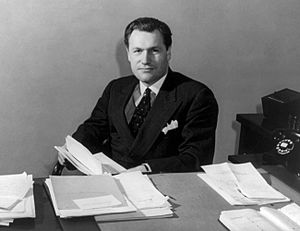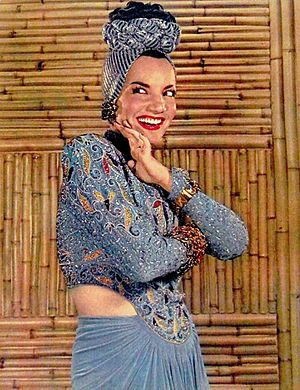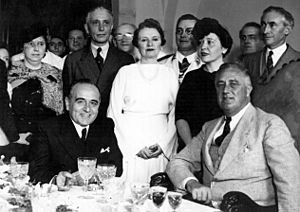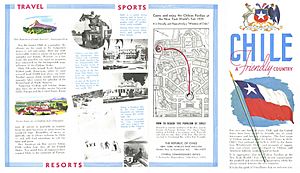Good Neighbor policy facts for kids
The Good Neighbor Policy (Spanish: Política de buena vecindad Portuguese: Política de Boa Vizinhança) was a special plan for how the United States would act towards countries in Latin America. It was started by US President Franklin D. Roosevelt.
This policy meant that the US would not interfere in the daily lives or governments of Latin American countries. It also aimed for the US to be a "good neighbor" and work together with these nations. The main goal was to create new ways for countries to trade and to make the US more influential in the region. However, many Latin American governments were not sure about this new approach at first.
Contents
Why the Good Neighbor Policy Started
In the early 1900s, the United States often sent its military into Latin American countries. This was usually to protect US business interests. After a rule called the Roosevelt Corollary in 1904, the US would sometimes use military force. This happened if debts were not paid, US businesses felt threatened, or if access to natural resources was blocked. These actions made many Latin Americans distrust the US. They also caused bad feelings towards the United States.
For example, President Woodrow Wilson sent US troops into Mexico several times. He also sent troops to Haiti and the Dominican Republic. For many years, the US military stayed in Nicaragua. They even helped choose a president there who was friendly to the US. These actions showed a pattern of the US getting involved in other countries' affairs.
Roosevelt's New Plan
A Promise of Non-Intervention
President Roosevelt wanted to show that the US would no longer interfere in Latin America. On March 4, 1933, he gave a speech where he talked about being a "good neighbor." He said the US would respect itself and the rights of others. This meant the US would stop using military force in the region.
Cordell Hull, Roosevelt's Secretary of State, confirmed this idea. At a meeting in Montevideo in December 1933, he stated: "No country has the right to intervene in the internal or external affairs of another." Roosevelt himself then made it clear: "The definite policy of the United States from now on is one opposed to armed intervention."
How the Policy Changed Things


The Good Neighbor Policy led to some big changes. In 1934, the US Marines left Haiti. Also in 1934, the Platt Amendment with Cuba was canceled. This amendment had given the US the right to interfere in Cuba. In 1938, Mexico took control of foreign-owned oil companies. The US then negotiated fair payment for these companies.
The US also started a "Good Neighbor fleet" of ships. These ships carried goods and passengers between the US and South America. This helped improve trade and travel.
The policy also tried to change how Americans saw Latin Americans. Roosevelt created the Office of the Coordinator of Inter-American Affairs (OCIAA) in 1940. Nelson Rockefeller was put in charge. The OCIAA used movies and radio to show Latin America in a good way. They wanted to get rid of old, negative ideas about Latin Americans. For example, they encouraged filmmakers to hire Latin Americans. They also asked them to make movies that showed Latin America positively. Famous star Carmen Miranda became a symbol of this policy. Her films, like The Gang's All Here, promoted the Good Neighbor Policy.
Radio also played a role. In 1941, CBS Radio worked with the OCIAA to create "La Cadena de las Américas." This radio network broadcast news and cultural shows across Latin America. It helped share the ideas of the Good Neighbor Policy. Walt Disney also made films like Saludos Amigos (1942) and The Three Caballeros (1944). These films helped promote friendship between the Americas.
By the end of World War II, Latin America was very supportive of US foreign policy.
Working Together for Peace
By 1936, many parts of the world were at war. Because of this, the US called for a special meeting of the Pan-American Union. This meeting was held in Buenos Aires, Argentina. President Franklin D. Roosevelt went in person. He spoke about how American countries wanted to live in peace. He also said they would work together if there was any outside attack.
The Buenos Aires meeting led to more progress at the Pan-American Conference in Lima in 1938. There, American countries agreed to solve problems peacefully. They also agreed not to interfere in other countries' affairs. This agreement was called the "Declaration of Lima."
The 1939 World's Fair
The 1939 New York World's Fair was a great place to promote friendly relations. It happened as the threat of World War II was growing. The fair aimed to show peace and cooperation between nations. Many countries from Latin America were there, including Argentina, Brazil, and Mexico.
Each country used the fair to show off its culture. They wanted to seem more appealing to people around the world, especially in the US. They promoted tourism and tried to show how similar they were to the United States. This helped to change negative ideas about Latin America.
End of the Policy
The Good Neighbor Policy ended around 1945, when the Cold War began. The US then felt it needed to protect the Western Hemisphere from the Soviet Union. This new focus meant the US started to get involved in Latin American affairs again. This went against the main idea of the Good Neighbor Policy.
After World War II, the US focused on helping Europe and Japan rebuild. This meant Latin American countries were largely overlooked. However, in the late 1950s, the US tried to strengthen ties again. They launched the Inter-American Development Bank and the Alliance for Progress. But during the Cold War, the US government also supported some right-wing governments.
Good Neighbor Policy in Brazil
Brazil had the biggest office of the Coordinator of Inter-American Affairs. This was because Brazil was very important during World War II. The US sent a lot of propaganda to Brazil, including films and cartoons. Many American artists and thinkers visited Brazil to help with the Good Neighbor Policy. This included Walt Disney and Orson Welles. US propaganda films were seen by millions of Brazilians during the war.
Good Neighbor Policy in Cuba
The Good Neighbor Policy led to the end of the Platt Amendment in Cuba in 1934. However, the US still had some influence. For example, the US government suggested that Cuba should increase the amount of Cuban sugar that America bought. This was meant to help Cuba's economy.
See also
 In Spanish: Política de buena vecindad para niños
In Spanish: Política de buena vecindad para niños



